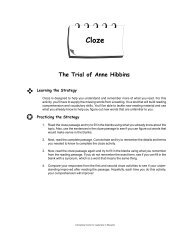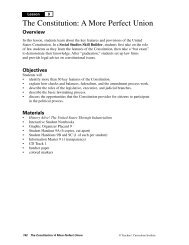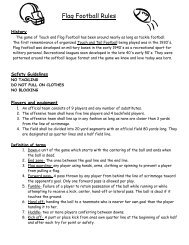safe-catch
safe-catch
safe-catch
You also want an ePaper? Increase the reach of your titles
YUMPU automatically turns print PDFs into web optimized ePapers that Google loves.
SAFECATCH<br />
Bank Robbery<br />
Suppression &<br />
Apprehension Program
SAFECATCH<br />
Follow the link:<br />
http://video.google.com/videoplaydocid=-<br />
7910921090914131395&ei=18TTSPfhN4z-<br />
qAOLvZS5Ag&q=bank+robbery+investigation&hl=en<br />
(If you have an internet connection, highlight, right click, left t click “open hyperlink”)<br />
While watching the video take notice of your<br />
current security policy relating to bank<br />
robbery. Do you recognize weaknesses that<br />
can <strong>safe</strong>ly be corrected
BANK ROBBERY IS NOT THE PRICE OF<br />
DOING BUSINESS, IT’S S THE COST OF<br />
DOING NOTHING!!!!!<br />
This suspicious customer stood in line with other customers<br />
for over two minutes. Because no one in the bank greeted<br />
him in the lobby, the teller had to become his victim at her<br />
window.
SAFECATCH<br />
STOP THIS ROBBERY!!!<br />
STOP THIS ROBBER’S S FUTURE<br />
ROBBERIES!!!<br />
EVERY BANK ROBBERY IS<br />
EVERY BANK’S S PROBLEM
What is SAFECATCH<br />
SAFECATCH IS A TWO PRONG APPROACH<br />
USED IN ADDRESSING ISSUES RELATED TO<br />
BANK ROBBERY. SAFECATCH IS AN<br />
ACRONYM, EACH LETTER REPRESENTS A STEP<br />
OR PHASE.<br />
SAFE IS THE PREVENTIVE PRONG, IT IS<br />
BELIEVED THAT AS MUCH AS 90% OF ALL<br />
BANK ROBBERIES CAN BE PREVENTED.<br />
THE CATCH PRONG BRINGS BANK EMPLOYEES<br />
INTO A PARTNERSHIP WITH LAW<br />
ENFORCEMENT, TEAMING TOGETHER TO<br />
SAFELY APPREHEND THE ROBBER.
SAFECATCH<br />
• S = SCAN your work area looking<br />
for suspicious persons or<br />
incidents<br />
– Don’t t suppress “The Gift of Fear”<br />
• A term used by noted author Gavin de<br />
Becker, the “gift of fear” is something that we<br />
are all born with<br />
• Trust those instincts that tell you something<br />
is not right in this picture
S = SCAN your work area<br />
There are many examples of bank<br />
employee’s s not scanning their environment<br />
and being surprised by a suspicious<br />
customer who becomes a robber.<br />
WHY<br />
Have you heard the following words<br />
“Don’t t Be a hero, it’s s not worth it, don’t t do<br />
anything other than nothing.”
S = SCAN your work area<br />
If told to do nothing, that is what<br />
you will do; before, during and<br />
after the robbery.<br />
The Uncle Fester Bandit could have<br />
been stopped on robbery five, he<br />
went on to rob three more times,<br />
for a total of eight victim tellers.
HOW COULD YOU MISS<br />
HIM<br />
Uncle Fester<br />
“Uncle Fester Bandit”
SAFECATCH<br />
• A = Alert others to your<br />
suspicions. If the threat is<br />
immediate, utilize the “walk-<br />
away” strategy.<br />
For any of the following strategies to<br />
be effective, you must alert your<br />
“point of contact” or other employees<br />
of your suspicions.
SAFECATCH<br />
• Who is my pre-determined point of<br />
contact<br />
– This can anyone in your branch who is<br />
prepared to greet a suspicious customer.<br />
• Branch Manager<br />
• Branch Operations Manager<br />
• Customer Service Supervisor
What If I’m I m Wrong!<br />
The beauty of SAFECATCH - you are<br />
never wrong! Even when you may be<br />
wrong, you’re right! How can that be<br />
Because we are going to treat subjects<br />
that present us with the “gift of fear”<br />
exactly like we would treat a customer<br />
with whom we want to develop a<br />
banking relationship.
What If I’m I m Wrong!<br />
Legitimate Needs vs. Criminal Intent<br />
– Legitimate Customer’s s Thoughts:<br />
• My business really matters to this bank!<br />
• I’m m being provided prompt, personal<br />
attention!<br />
– A Would-Be Bandit’s s thoughts:<br />
• Anxiety: “I I think they know why I’m I m here!”<br />
• Paranoia: “I I bet they already called the<br />
police!!”<br />
• Fear of Capture: “If I don’t t get out of here<br />
fast, I’m I m going to jail!”
Stranger Danger<br />
Walk-Away<br />
Sometimes you will not receive the “Gift of Fear” until the last<br />
moment.<br />
If an approaching customer presents you with the “Gift of<br />
Fear” politely excuse yourself and walk away to another<br />
employee or the point of contact.<br />
Let them know of your suspicion, if the customer stays at<br />
your window he is most likely just that, a customer. Either<br />
you or the point of contact should return, apologize as you<br />
normally would for any delay and continue the transaction.
DEMAND MADE or<br />
WEAPON DISPLAYED<br />
• If a subject has made a robbery<br />
demand, makes it as you turn to walk<br />
away or has displayed a weapon, DO<br />
NOT WALK AWAY OR CONTINUE<br />
TO WALK AWAY!<br />
– Comply with the demand to the best of<br />
your ability and move immediately to the<br />
CATCH phase
SAFECATCH<br />
• F = Friendly: By being friendly, we<br />
take control and keep the subject in<br />
his “role. role.”<br />
– When a would-be note job bandit enters your<br />
branch, he “assumes the role” of one of your<br />
customers. He must maintain this “role” all the<br />
way up to your teller window. Only then does he<br />
assume a new role, that of a bank robber.<br />
– By overtly treating him as a customer well<br />
before that point, there is a strong possibility<br />
that you will be able to keep him in that<br />
customer “role” thus never allowing him to<br />
assume the role of a robber.
SAFECATCH<br />
• Friendly, friendly, friendly!<br />
– For example, you may approach the<br />
subject and say: “Hi, my name is (so-<br />
and-so) and I’m I m the (your position) here.<br />
I don’t t recognize you as one of our<br />
customers. You must be here to open a<br />
new account.”<br />
– By approaching with a warm, friendly<br />
greeting, you just removed the subject’s<br />
disguise of anonymity and invisibility.
BE A HERO<br />
IT’S S WORTH IT<br />
Remember, you are approaching a customer, not a bank<br />
robber. Odds are, everyday someone enters your branch that<br />
gives you a moment of pause.<br />
If no demand has been made or weapon displayed, they are<br />
customers.<br />
If you do nothing when these individuals enter your branch,<br />
the teller will be left to make the greeting, she has no choice.<br />
Be her hero, you will either prevent it, comply with it<br />
or develop a new customer
Contact in the lobby as close to the exit as<br />
possible.
SAFECATCH<br />
• E = EXIT: Immediately after the<br />
greeting, provide an opportunity<br />
for the subject to exit.<br />
– Build Your Buffer: : Once the customer<br />
has stated why he is in your branch, you<br />
must break contact and walk away<br />
towards a location separate from the<br />
teller line. As you walk away state, “I I can<br />
help you over here, I just need your ID.”
SAFECATCH<br />
• No penalty for early withdrawal!<br />
– The subject, having his anonymity taken away and<br />
provided a ready-made excuse will most likely pat<br />
his pockets and state, “OH, I forgot my I.D. in the<br />
car. I’ll I<br />
be right back.” Then he will turn around<br />
and leave.<br />
• Report your suspicions to 911<br />
– If the subject entered in the role of a customer<br />
and was provided the above level of service and<br />
left without conducting business, he most likely<br />
was there to commit a crime. Call 911 to report<br />
suspicious activity, then notify the Bank Security<br />
Officer.
WHAT DID WE JUST DO<br />
By implementing the SAFE portion of the<br />
SAFECATCH program you have empowered<br />
yourself and staff to take control over the<br />
<strong>safe</strong>ty of the branch.<br />
No longer is the robber in control, you are.<br />
You have <strong>safe</strong>, effective strategies and<br />
choices to protect yourself, fellow employees,<br />
customers and your institution.
REMEMBER!<br />
If at any point during the SAFE phase, a<br />
bandit actually makes a demand or displays<br />
a weapon, immediately move to the CATCH<br />
phase!<br />
We never do anything in the SAFECATCH<br />
program to cause an escalation. There is<br />
no confrontation aspect within the program,<br />
if a demand is made we abandon all SAFE<br />
strategies, comply the best we can, and<br />
move to the CATCH phase.
SAFECATCH<br />
ATCH<br />
• C = Call 911 as soon as possible!<br />
– You Call, They Haul!<br />
• If you are the victim teller, you make the call to<br />
911. The victim teller is the only one with details<br />
that responding officers need.<br />
– The “Alarming Truth” About That<br />
Button.<br />
• Do not rely on your alarm button to notify police.<br />
– Your alarm button is part of the corporate notification<br />
system. 911 is the emergency response system.
SAFECATCH<br />
ATCH<br />
• Help Me Help You<br />
– As soon as the bandit’s s hands hit the exit door<br />
or as soon as you feel <strong>safe</strong> to do so, pick up<br />
the phone and call 911, IT MUST BE THE<br />
VICTIM TELLER<br />
– While you are on the phone, wave your hand<br />
to signal to your coworkers that you have<br />
been robbed.<br />
• DO NOT leave your workstation to get approval for<br />
this call. You are hereby empowered to proactively<br />
partner with law enforcement to call 911 if you’ve<br />
been robbed.
SAFECATCH<br />
• A = Action: if you see a co-worker<br />
on the phone with their hand in<br />
the air, take ACTION!<br />
– If you see a teller on the phone with her<br />
hand in the air point at her and confirm,<br />
“were you robbed”<br />
– If yes, every second counts, you are now<br />
partnering with law enforcement, as a<br />
partner it is your job to take action.
SAFECATCH<br />
If you get a positive response from the<br />
victim teller, you are to yell out for all<br />
branch employees and customers to<br />
hear:<br />
– “We were just robbed but we’re <strong>safe</strong>.<br />
Again, we were just robbed but we’re <strong>safe</strong>.”<br />
• This allows rapid notification to all other branch<br />
employees so that all can move on to the next<br />
step…
SAFECATCH<br />
CH<br />
• T = Tactical: When notified a robbery has<br />
occurred, go to your pre-determined tactical<br />
location to observe fleeing subjects and<br />
vehicles.<br />
– Which way did he go Which way did he go<br />
• Choreograph and rehearse who will go to which window and on<br />
which side of branch after the bandit has fled.<br />
– He went that-away!<br />
away!<br />
• Try to get a vehicle description and direction of travel. The<br />
Victim Teller can then relay that information to 911.<br />
– NEVER FOLLOW SUSPECTS OUTSIDE THE BUILDING!
SAFECATCH<br />
• C = Cash: Limit the amount of money<br />
you hand out.<br />
– Rehearse Taking Out Demand Money!<br />
• Go through the motion so that in a real-life<br />
life<br />
robbery, you will limit the amount of cash you give<br />
out.<br />
• FBI statistics show that bandits return to branches<br />
they got a lot of money from!
SAFECATCH<br />
Rehearse grabbing your ones, fives,<br />
tens, your bait and just ONE $100 bill<br />
on top.<br />
Once you’ve given out your stack of<br />
bills, close your drawer and take a<br />
step back away from your drawer.<br />
If a suspect demands more money,<br />
then you should comply.
SAFECATCH<br />
Think of this as nothing more than<br />
another device you have available<br />
to you.<br />
If you can successfully limit the<br />
amount of cash you hand out, you<br />
decrease the chance of the robber<br />
returning to your branch or bank.
SAFECATCH<br />
• H = Help reduce bank robberies<br />
by committing to the proactive<br />
approach and partnership of SAFE<br />
CATCH.<br />
– By doing this, we will shift from merely<br />
reporting a crime to proactively<br />
partnering with law enforcement to<br />
prevent more bank robberies and aid in<br />
the capture of bank robbery suspects.
SAFECATCH<br />
By rehearsing as individuals and<br />
choreographing as a team, we will be more<br />
likely to react in a manner that keeps<br />
everyone <strong>safe</strong> and prevent further bank<br />
robberies.<br />
You are empowered to proactively partner<br />
with law enforcement to aid in the prevention<br />
and assist in the apprehension of bank robbery<br />
suspects!
DOES IT WORK<br />
SEATTLE MARKET<br />
Percent (%) Share of Bank Robberies within Seattle Metropolitan Market<br />
45<br />
40<br />
42<br />
41<br />
35<br />
32<br />
30<br />
25<br />
20<br />
19<br />
15<br />
10<br />
15<br />
16<br />
8<br />
12<br />
11<br />
11<br />
16 16<br />
12 12<br />
10 10<br />
8<br />
9<br />
5<br />
0<br />
BOA WAMU KEY BANK US BANK WELLS FARGO OTHERS<br />
Percent (%) Share of Branches within Seattle Metropolitan Market<br />
Percent (%) Share on a 5 year average<br />
Percent (%) Share from July 2007 - July 2008
BANK OF AMERICA<br />
US MARKET SAMPLE<br />
Percent (%) Share of Bank Robberies within Metropolitan Markets<br />
40<br />
35<br />
34<br />
30<br />
27 27<br />
25<br />
20<br />
15<br />
10<br />
6<br />
9<br />
9<br />
16<br />
15<br />
8<br />
13 13<br />
12<br />
21<br />
19<br />
18<br />
17<br />
15 15 15<br />
10<br />
14<br />
16<br />
11<br />
16<br />
15<br />
7<br />
9<br />
8<br />
13<br />
17<br />
5<br />
0<br />
NATIONAL<br />
SEATTLE<br />
PORTLAND<br />
SAN FRANCISCO<br />
LOS ANGELES<br />
LAS VEGAS<br />
DALLAS<br />
ATLANTA<br />
CHARLOTTE<br />
% Share of Branches within Metroplitan Markets 5 Year Average from July 2002 - July 2007<br />
1 Year Test Period from July 2007 - July 2008 (Post SafeCatch)<br />
MIAMI
SAFECATCH<br />
If you have any questions regarding the<br />
<strong>safe</strong>ty and security of your branch, contact<br />
your Security Officer, area law enforcement<br />
representative or area FBI representative .<br />
If you have any questions about the<br />
SafeCatch program you can also contact<br />
Seattle Division Special Agent Larry Carr at<br />
206-262<br />
262-20002000<br />
Presentation outline and statistics received from<br />
Special Agent Larry Carr, Seattle Division, FBI
















